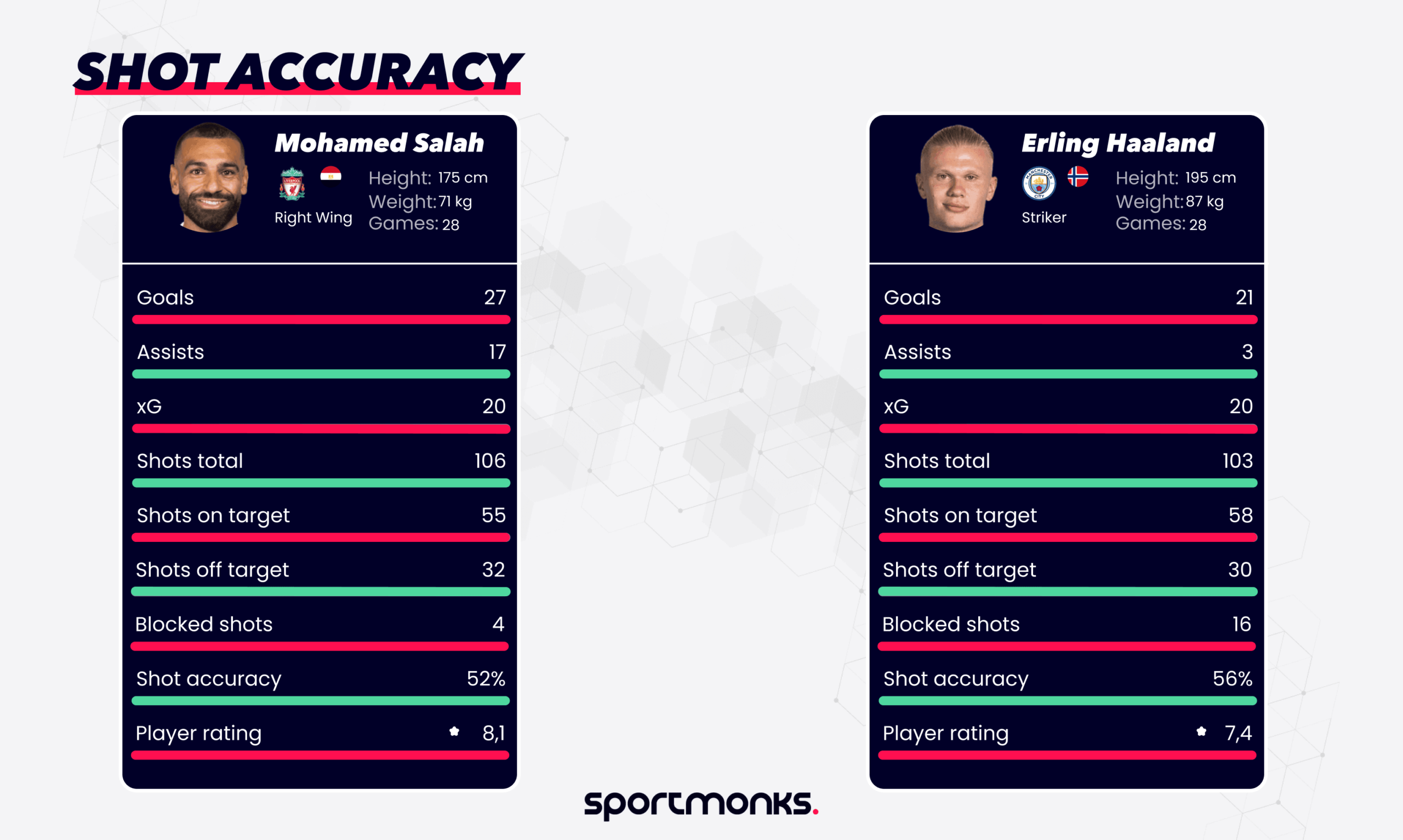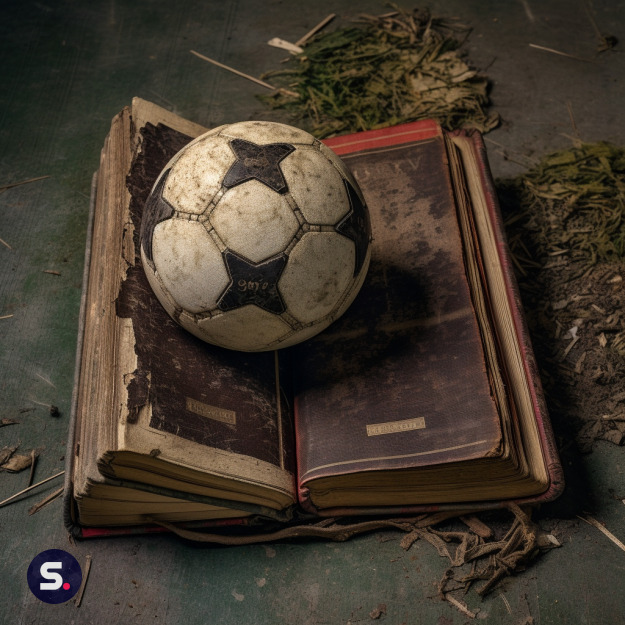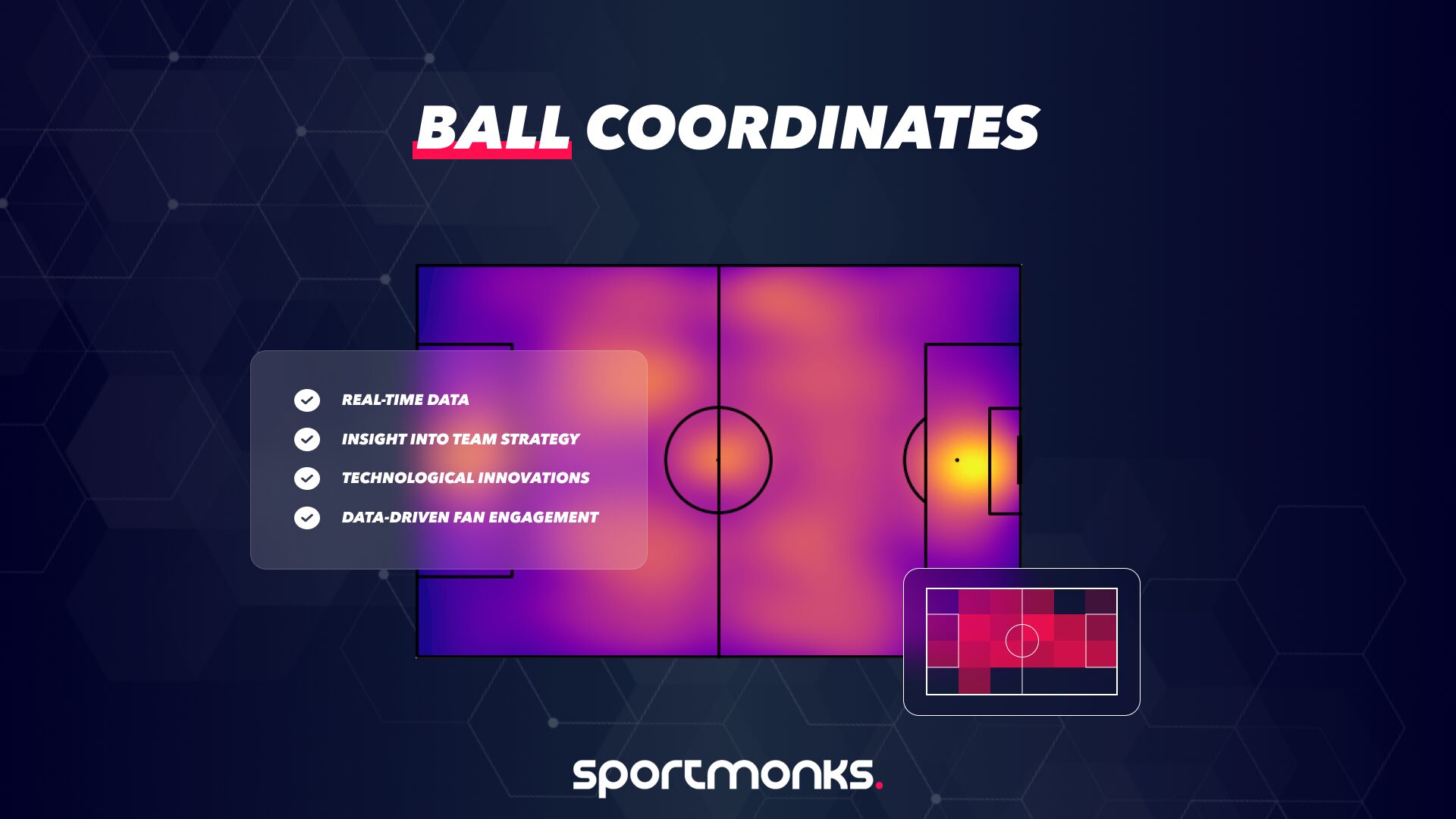
Contents
What is shot accuracy?
Shot accuracy provides a quantifiable measure of a team’s or individual player’s ability to place their shots on target. It’s a straightforward calculation:
Shot Accuracy = (Shots on Target / Total Shots) * 100
Let’s break down the components:
– Shots on target: These are shots that would have resulted in a goal if not for an intervention by the goalkeeper (a save) or a defender (a last ditch block). A shot that hits the post or crossbar and stays out of the net is not considered a shot on target. Similarly, a shot that is wide or high of the goal is also not on target.
– Total shots: This includes all attempted shots, regardless of whether they are on target, off target, or blocked.
For example, if a player takes 10 shots in a match and 6 of those shots are on target, their shot accuracy would be (6/10) * 100 = 60%.
It’s important to understand the nuances of this metric. While shot accuracy provides a valuable snapshot of shooting performance, it has limitations. A shot aimed directly at the goalkeeper from close range might be classified as “on target,” but it’s often a relatively easy save. Conversely, a curling shot aimed just inside the post that forces a spectacular diving save is also “on target,” but represents a much higher-quality chance. Therefore, shot accuracy should be considered in conjunction with other metrics, such as expected goals (xG), which takes into account factors like shot location, angle, and the type of pass, to provide a more comprehensive picture of shooting effectiveness. A high shot accuracy percentage doesn’t necessarily mean a player is a clinical finisher; they might simply be taking easier shots. Similarly, a lower shot accuracy might not indicate poor shooting, but rather a player attempting more difficult or long-range efforts. In short, shot accuracy is a useful but imperfect metric, and its interpretation requires context.
Factors influencing shot accuracy
Several factors contribute to a player’s or team’s shot accuracy, making it a complex interplay of skill, circumstance, and strategy. Understanding these factors is crucial for both analysing performance and developing strategies for improvement.
– Player skill and technique: A player’s fundamental shooting technique is skill level is important. This includes factors like striking the ball cleanly with the correct part of the foot, maintaining balance and composure during the shot, and accurately judging distance and power. Years of practice and refinement are necessary to develop consistent and accurate shooting. For this factor, strikers like Lewandowski have a better chance of having a better shot accuracy because most of their game has been centred around taking and finishing shots.
– Shot location and angle: The position from which a shot is taken significantly impacts its likelihood of being on target. Shots taken from closer range generally have a higher chance of accuracy, as do shots taken from more central positions. The angle of the shot relative to the goal also plays a crucial role. While close-range shots offer higher accuracy, they may also be more easily blocked. The expected goals (xG) metric, mentioned earlier, attempts to quantify the quality of a chance based on these factors. A shot by Federico Valverde is bound to generate less xG and be less accurate than a shot by Erling Haaland, since most of his shots come from outside the box and with a lot more bodies trying to block it.
– Pressure and time constraints: A player under pressure from defenders or with limited time to shoot may struggle to maintain accuracy. The added stress can affect decision-making and technique, often leading to rushed or poorly executed shots. An example could be Nunez’s miss against Aston Villa. With the score tied 2-2 and much of the second half played, he had the chance to tap in after Salah fed him through, but with the pressure from an on-rushing defender was able to di-stabilise him enough to send it over the bar. The ability to remain composed and focused in high-pressure situations is a hallmark of top-level strikers.
– Ball movement and trajectory: The speed, spin, and trajectory of the ball as it arrives at the shooter’s feet can significantly impact their ability to control the shot. A rapidly moving ball, a bouncing ball, or a ball arriving at an awkward angle can all make accurate shooting more challenging. We can reference the Harry Maguire miss very late in the game against Liverpool. Moments after the miss, fans and analysts alike criticised the United skipper, but upon a lot of replays, it was found out that the pass from Zirkzie was bouncing and a bit behind him, so it made it harder for him to convert.
– Opposition defence: A well-organised and disciplined defence can make it difficult for attackers to find space and get clean shots on goal. Defenders can close down shooting lanes, apply pressure, and block shots, all of which contribute to reducing shot accuracy. A team like Atletico, known for their defensive solidity under Simeone, are set up to stifle the opposition and force them to either rush chances or generate very low xG attempts at goal.
– Playing surface and weather conditions: The condition of the playing surface can also play a role. An uneven or wet pitch can make it harder for players to control the ball and execute their shots accurately. Similarly, bad weather conditions, such as rain or wind, can affect ball trajectory and make shooting more difficult. This tends to be the case a lot from November to March in Europe where it tends to rain and snow a lot, causing difficult terrains to play in.
– Mental factors: Beyond technical skill, mental factors like confidence, focus, and composure are essential for accurate shooting. A player who is confident in their ability and able to remain focused under pressure is more likely to convert chances. On the other hand, a player who is nervous or hesitant may struggle to execute their shots effectively. Other situations like a derby or a reunion with a recent old club could also affect a player’s psyche, and how they produce on the pitch.
Analysing shot accuracy
Analysing shot accuracy can provide valuable insights into both individual player performance and overall team effectiveness. Here are some key ways in which shot accuracy is analysed:
– Individual player analysis: Tracking a player’s shot accuracy over time can reveal trends in their performance. Comparing their shot accuracy to other players in similar positions e.g.,attacking players like centre forward vs centre forward) within the same league or competition can provide context for their effectiveness. Analysing shot accuracy in relation to other metrics, such as goals scored, assists, and key passes, can offer a more complete picture of a player’s attacking contribution. Coaches and analysts can use this information to identify areas for improvement and develop targeted training plans.
– Team analysis: Examining a team’s overall shot accuracy can reveal how efficient they are at converting scoring opportunities. Comparing a team’s shot accuracy to their opponents can provide insights into their relative attacking strengths and weaknesses. Analysing shot accuracy in conjunction with other team statistics, such as possession, shots per game, and chances created, can help identify areas where tactical adjustments might be needed. For example, a team with low shot accuracy despite creating many chances might need to focus on improving their finishing in the final third, by maybe adding a more potent striker or attacking midfielder to create better chances for his teammates.
– Tactical implications: Shot accuracy analysis can inform tactical decisions. For instance, if a team has a high shot accuracy from close range but struggles from distance, they might focus on creating more opportunities inside the penalty area. Conversely, if a team has several players with high shot accuracy from long range, they might employ tactics that encourage more shots from outside the box. Analysing shot accuracy in relation to different playing styles (e.g., possession-based vs. counter-attacking) can also reveal tactical trends and inform game plans.
– Using data and analytics: Modern football relies heavily on data and analytics. Shot accuracy is a key metric tracked by various data providers, such as Opta, Stats Perform, and Sportmonks. These companies collect detailed data on every shot, including location, type of shot, and outcome. This data is then used by analysts, coaches, and even fans to understand player and team performance in greater depth. Advanced analytics can also be used to create models that predict the likelihood of a shot resulting in a goal (xG), providing a more nuanced understanding of shooting effectiveness. These analytical tools are becoming increasingly important in modern football for both player development and tactical planning.
Sportmonks makes shot accuracy easy to follow by tracking player and team stats with clear detail. Want to know who’s hitting the target or how a team sets up chances? We’ve got live updates, shot breakdowns, and simple numbers like shots on target and pass success to show what’s working—whether it’s close-range finishes or long shots. With the European Plan at €39 monthly for 27 leagues, the Worldwide Plan at €129 monthly for 111 leagues, the Enterprise Plan with custom pricing for over 2,200 leagues, or a Custom Plan built for your needs, you’ll see every key play. Check it out at Sportmonks Football API Plans.
Improving shot accuracy
Improving shot accuracy is a continuous process that requires dedication, focused training, and a keen understanding of the game. Here are some key strategies for enhancing this crucial skill:
– Targeted training drills: Specific drills can be designed to address different aspects of shooting technique and improve accuracy. These might include drills focusing on striking the ball cleanly with different parts of the foot (e.g., instep, laces, side foot), drills for finishing under pressure from defenders, and drills for practising set pieces like free kicks and corners. Repetition is key to developing muscle memory and improving consistency.
– Video analysis and feedback: Reviewing video footage of past performances can be invaluable for identifying areas for improvement. Players can analyse their shooting technique, body positioning, and decision-making in different situations. Coaches can provide feedback based on this analysis, highlighting specific areas where adjustments can be made to improve accuracy. This process of self-reflection and feedback is essential for continuous development.
– Mental training and composure: Mental factors play a significant role in shooting accuracy, particularly in high-pressure situations. Developing composure and focus through mental training techniques can help players perform at their best when it matters most. Visualisation, mindfulness, and other mental exercises can help players manage stress and maintain focus during crucial moments. An example would be Arteta using noise machines to simulate the stadium environment for Arsenal before their match against Liverpool
– Positioning and movement off the ball: Creating high-quality scoring opportunities often depends on intelligent movement and positioning. Players who can find space in the box, make well-timed runs, and anticipate passes are more likely to receive the ball in good positions for shooting. Working on movement drills and understanding tactical concepts can help players create better scoring chances and improve their shot accuracy.
– Strength and conditioning: While technique is important, adequate strength and conditioning are also important for powerful and accurate shooting. Developing core strength, leg power, and balance can help players generate more power on their shots while maintaining control and accuracy. A well-rounded fitness regime can also help players maintain their performance levels throughout a match.
– Practice with both feet: Developing skill with both feet is a significant advantage for any player. Being able to shoot accurately with both feet expands a player’s options in attack and makes them less predictable for defenders. It also makes them harder to defend, since the opposition marker can’t try to trap a foot or running path of the attacker.
Shot accuracy in different contexts
Shot accuracy isn’t a universal constant. It can vary significantly depending on various contextual factors, offering further layers of analysis and understanding.
– League and competition differences: Different leagues and competitions often exhibit variations in average shot accuracy. Factors such as the overall quality of players, the tactical styles employed, and even refereeing standards can contribute to these differences. For example, leagues with more technically gifted players might see higher average shot accuracy compared to leagues where physicality and defensive organisation are more prominent. Analysing these variations can provide insights into the unique characteristics of different footballing environments.
– Playing style and tactical approach: A team’s playing style can also influence their shot accuracy. Teams like Manchester City that favour a possession-based approach and create numerous scoring opportunities through intricate passing moves might have a higher shot accuracy due to the quality of chances they create. On the other hand, teams that rely on counter-attacks and long-range shots might have a lower shot accuracy, as these types of shots are generally more difficult to convert or are executed in less time. Understanding the relationship between playing style and shot accuracy can help teams refine their tactical approach.
– Set pieces and direct free kicks: Shot accuracy is particularly crucial in set-piece situations, such as free kicks and corners. The ability to deliver accurate crosses and free kicks into dangerous areas can significantly increase a team’s chances of scoring. A team like Arsenal that underwent specialised training and practice have seen huge improvements in their setpiece game, scoring over 24 goals since the start of the 2023/24 season. Analysing shot accuracy from set pieces can reveal a team’s effectiveness in these crucial moments.
– Individual player roles and positions: A player’s role and position on the pitch can also influence their shot accuracy. Forwards, whose primary responsibility is to score goals, typically have a higher shot accuracy compared to defenders or midfielders. However, even among forwards, there can be variations in shot accuracy depending on their specific role and style of play. Some forwards might specialise in close-range finishes (i.e., fox in the box), while others might be more adept at scoring from distance (long-range specialist). Understanding these positional differences can provide a more accurate analysis of individual player performance.
– In-game situations and pressure: Shot accuracy can fluctuate throughout a match depending on the game situation and the level of pressure. Late in a game, when teams are chasing a goal, players might take more risks and attempt shots from less probable positions, which can lead to a decrease in shot accuracy. Similarly, players under intense pressure from defenders or facing a crucial penalty shootout might experience a drop in accuracy due to the increased stress. Analysing shot accuracy in relation to these in-game situations can reveal how players perform under pressure and how teams adapt their shooting strategy as the match progresses.
Conclusion
Scoring goals is what football’s all about, and hitting the target is the first step. Shot accuracy tells us how good a player or team is at just that. It’s not as simple as it looks, though. Loads of things play a part, from how good someone is at striking the ball to the pressure they’re under.
Looking at shot accuracy helps players and coaches figure out what they’re doing well and where they can improve. And with resources like Sportmonks, there’s a ton of data to dig into. Sportmonks gives you the numbers on everything from where shots are taken to how often they hit the target. This kind of information can help teams get better at creating chances and finishing them off.
FAQs about shot accuracy
Shot accuracy = (Shots on Target / Total Shots) × 100
- Shots on target: These are shots that would have scored without a goalkeeper save or a last-ditch block by a defender on the goal line. A shot hitting the post or going wide isn’t on target.
- Total shots: Includes all attempts—on target, off target (wide/high), or blocked by outfield players before reaching the goal line.


